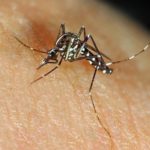Climate and children’s health: A conversation with Dr. Aaron Bernstein

When Boston Children’s Hospital pediatrician Dr. Aaron Bernstein was in medical school, he was told that climate change — an interest of his since 7th grade — belonged in the realm of politics, not medicine. One professor told him flat out, “You’re trying to fit a square peg in a round hole.”
But another professor connected him with what is now the Center for Climate, Health, and the Global Environment (C-CHANGE) at the Harvard T.H. Chan School of Public Health. The center’s mission is to use scientific knowledge on the health benefits of climate solutions to increase understanding and action.
Pediatricians care about prevention. We’re not interested in waiting for kids to get sick or disabled, we want to keep them healthy.
That agenda lit a fire under Bernstein. Today, he is interim director of Harvard Chan C-CHANGE. He also leads Climate MD, a C-CHANGE program that encourages physicians to connect climate change to health here and now.
To Bernstein, speaking out about the connections between climate and children’s health is a natural part of being a pediatrician. In fact, the American Academy of Pediatrics was the first major medical organization to issue a statement on climate change, in 2007.
“Pediatricians care about prevention; we’re not interested in waiting for kids to get sick or disabled,” he says. “We want to keep them healthy.”
Healing disease, protecting the planet
As an attending physician in hospital medicine, Bernstein has treated children with diseases carried by ticks and mosquitoes (which are spreading as the world warms up), and trauma from natural disasters. But he also sees strong links between climate change and some of the biggest problems in children’s health — like asthma, obesity, and mental health challenges. And he sees climate change and such health problems as sharing some of the same solutions.
In the case of asthma, phasing out gasoline-powered vehicles would reduce air pollution, a major cause of breathing difficulties in children, especially poor children of color. It’s estimated that as many as 1 in 5 American children develop asthma from breathing vehicle exhaust. At the same time, it would reduce emissions of greenhouse gases that are blanketing and warming the earth.
Many interventions for obesity are good for the climate as well. Creating green spaces and urban parks encourages kids to be active; it also helps absorb carbon from the atmosphere and provides shade, alleviating urban “heat islands.” Riding bikes instead of driving reduces our carbon footprint, as does eating healthier plant-based meals. (Meat production is a major contributor to greenhouse gas emissions.)
Mental health in children, especially adolescents, has reached crisis levels, anxiety over climate change may be exacerbating mental health concerns. Bernstein cites a Danish study in which children exposed to the most green space were only half as likely to have mental health diagnoses as children exposed to the least green space.
“These are all win-wins,” says Bernstein. “We can make choices in this decade that profoundly shape our children’s existence.”
Heat and health
A warming world is leading to more frequent and more intense heat waves. Bernstein recently led the first large-scale study of the effects of heat waves on child health. Heat waves are especially dangerous for children, who spend more time outdoors and whose smaller bodies may be more vulnerable to dehydration. Heat waves can also make pollution and air quality worse.
Climate, deforestation, and pandemics
Animals and humans are increasingly coming into contact as people cut down forests, hunt, and engage in the wildlife trade. As a result, animal viruses sometimes spill over into humans. COVID-19 is the latest zoonotic pandemic; others include swine flu, bird flu, and HIV. In a recent article in Science Advances, Bernstein and colleagues call for more virus surveillance, better management of wildlife trade, and sharply reducing deforestation to prevent pandemics. The last two measures would also help maintain biodiversity, which Bernstein and his colleague Eric Chivian, MD, have shown to be vital to human health, and curb climate change.
The study looked at 3.8 million emergency department visits in 47 U.S. children’s hospitals during the late spring and summer, and found that hot days increased children visits. Heat-related illnesses like dehydration drove some of the visits. But children also made visits for other problems not seen in adults. These included intestinal bacterial infections, ear infections, skin and soft-tissue infections, blood disorders, and seizures.
Ear infections could be the result of kids swimming in the hot weather and getting “swimmer’s ear.” Intestinal infections could result from picnics and food being left unrefrigerated. Headaches and seizures could result from dehydration. But other conditions, like blood and immune system disorders, are more mysterious and will need further research, Bernstein says.
Climate-informed medicine
Bernstein believes health care professionals have a role to play in helping families cope with the effects of climate change. Recently, he and his colleagues published a guide for pediatricians on climate-informed primary care.
“When we send children home from the hospital during a heat wave, we should consider whether they are going to a place without air conditioning. If a child has had surgery and lives in a fifth-floor walkup up with no AC, they’re at higher risk. Or, if they have air conditioners, can they afford to run them? Do they have access to a cooling center? We need to ask and make sure the child has a safe place to recover.”
Bernstein calls this approach “patient-centered climate resilience.” It also applies to hurricanes, floods, and other weather events driven by climate change.
Questions to consider might include:
- Will the family have access to food and clean drinking water?
- Will they have access to electricity to run ventilators and other medical equipment in the event of a power outage?
- Might their access to medications be disrupted?
- Is their house damp and moldy due to flooding?
- Does the child need referral to mental health services?
“We can add questions like this to our other standard screening questions like, ‘Do you wear a seatbelt?’ or ‘Is there a firearm in your home?’” says Bernstein. “A lot of action can happen in clinics. We can make a difference.”
Related Posts :
-

Rising global temperatures tied to rising antibiotic resistance
A new data analysis suggests that two rising public health threats — climate change and antibiotic resistance — are related. The study, ...
-

Addressing inequities in asthma by focusing on children’s environments
Asthma strikes children in low-income urban areas especially hard, more often sending them to the hospital. For more than 20 years, ...
-

Lead exposure remains a problem for some children
Lead poisoning has been with us since the beginning of the Industrial Revolution. But it wasn’t until the late 1970...
-

The threat from mosquito-borne diseases: Forecasting mosquitoes’ global spread
Outbreaks of mosquito-borne illnesses like yellow fever, dengue, Zika and chikungunya are rising around the world. Climate change has created ...





